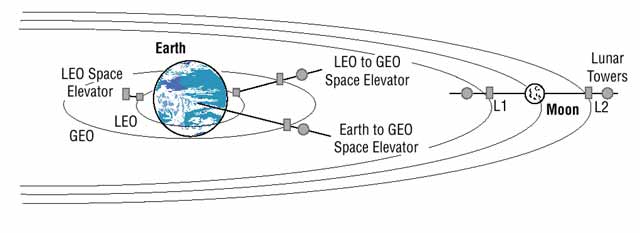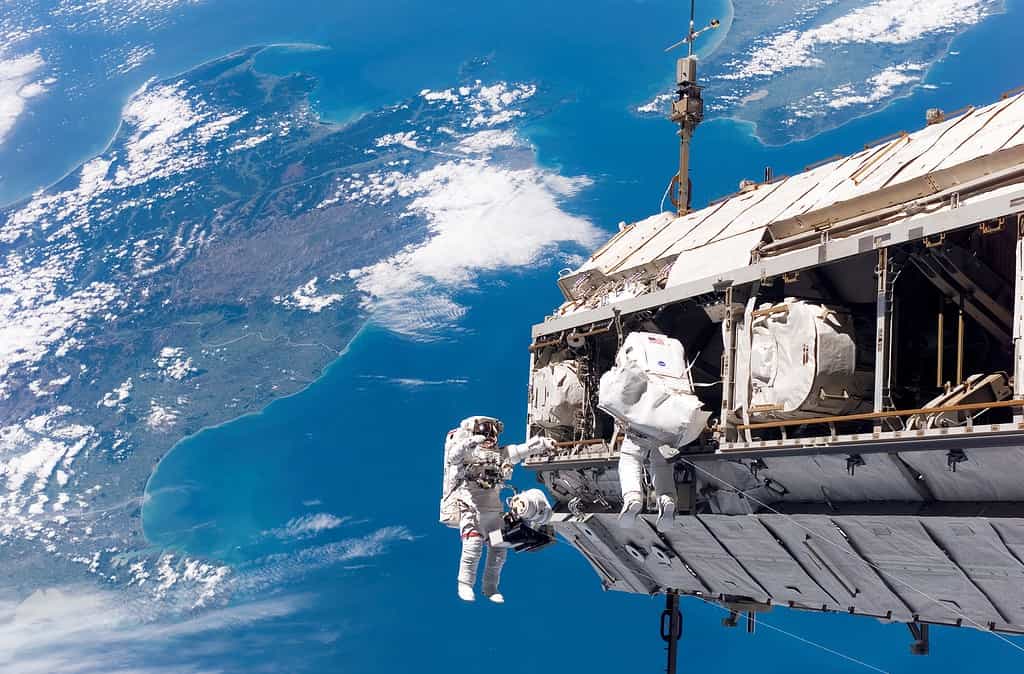Today, science fiction is rapidly becoming science fact. Artificial Intelligence, self-driving cars, and billionaires shuttling tourists to space in private rockets are already part of our world. However, two of the wildest ideas are still just dreams: space elevators and space skyscrapers. How would they work and how could they fail? And is the risk worth the investment?
Space Elevators

©Smitherman, D, Public domain, via Wikimedia Commons – License
A space elevator is a proposed transportation system to get payloads into Earth orbit, or back to the surface, far cheaper, cleaner, and safer than launching hundreds of rockets. If it materializes, this dream could make it much easier for regular people to visit, live, or work in space.
Some Assembly Required

Nanotubes have densely packed atoms of carbon.
©Taner Yildirim (The National Institute of Standards and Technology – NIST), Public domain, via Wikimedia Commons – License
A typical space elevator concept is to attach a super-strong, lightweight cable to a station on land or to a sea-based platform. Carbon nanotubes are a new technology that might become the chosen cable material. A counterweight at the other end – perhaps a small asteroid repositioned for the purpose – would orbit 89,900 miles (144,000 km) away – a third of the distance to the Moon! This is more feasible than it sounds. NASA’s 2022 DART mission successfully made a permanent change to the orbit of a small asteroid by crashing a rocket into it.
A Cheap Ride Into Space

One day space elevators could make visiting space an affordable, routine occurrence.
©NASA, Public domain, via Wikimedia Commons – License
With the counterweight locked into orbit, centrifugal force would pull the cable taut. The system would be located above the equator to achieve a geosynchronous orbit, remaining stationary above a point on Earth. Transports, called “climbers” would move up and down the cable to release payloads into orbit. On the return trip, climbers could be loaded up with Earth-bound payloads. These might include passengers, equipment in need of repair, or valuable minerals mined off-planet.
Space Skyscrapers
7,000 Floors of Fun

Dubai’s Burj Khalifa is currently the world’s tallest building. The Analemma Tower would be 37 times taller!
©Tavarius/Shutterstock.com
A space skyscraper is a similar concept. The New York-based firm Clouds Architecture has made the most detailed proposal. Named the Analemma Tower, it would be by far the largest and tallest building ever constructed. It would be up to 100,000 feet high (32,000 m), meaning it would have room for perhaps 7,000 floors and hosting, say, a half-million people. Compare these numbers to the Burj Khalifa, the world’s current tallest skyscraper. It stands approximately 2,700 feet tall (828 m) and has 163 floors, including maintenance levels. About 10,000 people live or work in the building.
Count the Stars, Any Time of Day
The Analemma Tower would never touch the ground but instead would hang from one or more cables attached to an orbiting asteroid 31,068 mi (50,000 km) above the earth’s surface. The bottom floors would hover 11,000 feet (3,400 m) above the Earth, while the top would soar all the way up to 105,000 feet (32,000 m). Helicopters or other transports would bring residents and visitors back and forth between the building’s lower floors and the ground. The upper floors would offer views of the star-studded darkness of space with the curvature of the Earth up to 19 miles (30.5 km) below.
The ULTIMATE Mobile Home
Like the space elevator, this structure would be suspended from a geosynchronous satellite. However, it would not be limited to an equatorial location. A geosynchronous orbit above any point on the planet other than the equator will follow a “figure 8” pattern due to the angle and wobble of the Earth in its orbit: an orbit called an “analemma.”
This means the Analemma Tower would not stay in one place. Instead, it would never stop moving, tracing the same looping path from New York City to South America and back again in 24 hours, day in and day out. Moving at a speed of 300 mph (186 km/h), it would be faster than the current fastest bullet trains on Earth. This means no opening windows or stepping out on a balcony for fresh air.
What Goes Up, Must Come Down

This image of a ballistic missile launch suggests how a falling space elevator cable might burn in the atmosphere and rain fiery debris across the landscape.
©https://commons.wikimedia.org/wiki/File:Minuteman_III_ICBM_operational_test_launch_(6530663).jpg – License
These futuristic projects could help humans access and develop space resources in an unprecedented way. But the downsides could be catastrophic. Consider:
- These projects will cost hundreds of billions of dollars. It may take quite a long time for them to become profitable enough to recover the upfront costs.
- We don’t have materials that are lightweight and strong enough without major technological breakthroughs.
- Both will be vulnerable to Earth- and space-based dangers, including collisions with birds, airplanes, space debris, or micrometeorites, hurricanes, solar storms, technological failure, or deliberate acts of sabotage or war.
- If either of them crashes through the atmosphere to Earth, flaming debris could fall across a wide area.
- Evacuation of tens or hundreds of thousands of people from space megastructures would not be possible in the event of a sudden catastrophic failure. The logistics and transport capability would be prohibitive.
Are They Likely to Be Built?

New technologies developed for space megastructures could transform life on Earth as well as in space.
©PopTika/Shutterstock.com
Space Elevator: Possibly
You might be surprised to know that many scientists think there is a rather good chance the space elevator will be built one day. Institutions are betting real money on it. In the past 20 years competitions like Elevator:2010, the Robogames Space Elevator Ribbon Climbing competition, the Space Elevator Games, and the European Space Elevator Challenge have offered cash prizes to incentivize the development of different technologies needed for the project. A 2019 study by the International Academy of Astronautics concluded that a space elevator seems feasible and that rapid advances in materials sciences are making it a more realistic possibility.
Space Skyscraper: Probably Not
A megastructure such as the Analemma Tower would be a vastly more complex and expensive undertaking than an elevator. Most floors would have to be completely airtight and pressurized with no leaks. The building would have to withstand different external air pressures and temperatures at different levels. Even if all the technical hurdles were overcome, the economic reality is that there might not be enough demand to live and work in space to make such a structure financially self-sustaining. That having been said, a more practical step toward developing the technologies and logistics of living in space might be to construct smaller-scaled habitats under the ocean or in harsh environments like Antarctica. The consequences of failure in those experiments would be far more forgiving than a city crashing from the sky.
The photo featured at the top of this post is © studio23/Shutterstock.com
Thank you for reading! Have some feedback for us? Contact the AZ Animals editorial team.






